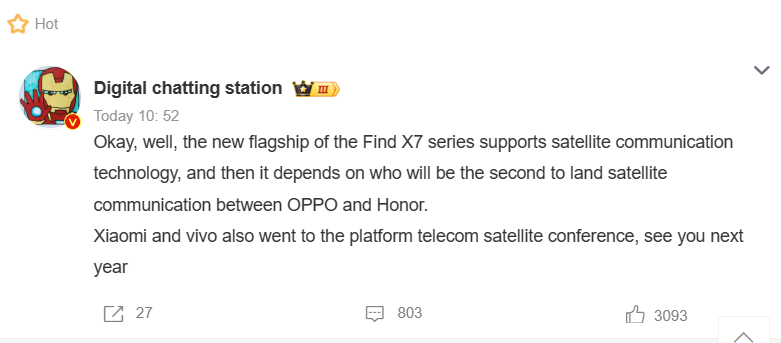Digital Chat Station on Weibo on November 10th reported that OPPO‘s next-generation Find flagship, the OPPO Find X7 series is going to support satellite connectivity. OPPO has also announced this on the company’s official WeChat.

Following in the footsteps of Huawei, which pioneered domestic satellite communication capabilities with its Mate 50 and Mate 60 series, OPPO aims to join the club with its Find X7 series devices.
Satellite connectivity is a communication process where your smartphone communicates through the satellite, instead of using cellular service. This is an engineering Marvel for a smartphone because it manages to connect to the nearest orbiting satellite without inheriting the radio antenna of older satphones. We have explained in detail what satellite connectivity in your smartphone is, in case you feel curious.
The integration of satellite communication technology empowers smartphones to establish connections even in extreme scenarios where cellular networks are absent, ensuring communication and potential rescue efforts.

The Chinese smartphone giants, including OPPO, Huawei, Xiaomi, Vivo, and Honor, are convening in Guangzhou to collaborate with China Telecom on advancing the implementation of “mobile phone direct communication to satellite” technology. It aims to provide users with reliable communication channels in challenging situations.
The Huawei Mate 50 series devices were only capable of sending short text messages and helping you with navigation by communicating through China’s BeiDou satellite network. However, its successor, the Huawei Mate 60 Pro managed to offer calling through the satellite in a single iteration. It lets you make and receive calls through the satellite. Now it remains to be seen what OPPO has under its sleeves for the upcoming Find X7 series.
OPPO’s venture into this technology (via DCS) indicates a future where smartphones can seamlessly connect with the outside world, even when conventional networks are unavailable.
While you won’t frequently use this functionality and may not appreciate this as much as you do the routine improvements in design or processing capabilities, it becomes the only feature that you want in your smartphone when you do need it, and this is what makes this connectivity feature stand out from the rest.
Related:
- Oppo’s upcoming Find X-series phone to pack Dimensity 9300, Find X7 likely to feature it
- Huawei P70 could launch with in-house cameras over Sony sensors
- What is Satellite Connectivity on Smartphones and How Does it Work?
(Source)






